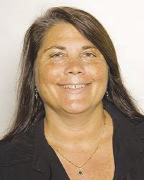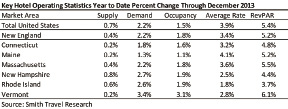While plausible caution invariably lingers among the lodging industry, hotel performance continues its path of steady improvement since the 2008 recession. As 2013 came to a close, the U.S. revealed another strong uptick in figures: increasing 1.5% in occupancy, 3.9% in average rage, and consequently rising 5.4% in RevPAR. In the fourth year of its recovery, the hotel industry can attribute most of this success to the 2.2% increase in demand and 3.9% increase in average rate.
While revenues per available room (RevPAR) for the region grew 5.4% in 2013, the RevPar in the New England region experienced 5.2% during the same time period. Here's the good news for this region:
* The region was only slightly behind in terms of RevPAR, exceeding the national growth rate for occupancy and recording the same rate of growth in demand;
* Two states (Massachusetts and Vermont) outpaced the national growth rates in RevPAR and occupancy; and
* Demand growth in all but two of the New England states was equal to or above the national average.
While this is the second year in a row where the region finished behind the nation in terms of RevPAR growth, it was much closer, lagging only .2% behind versus 1.2% last year. One reason for the region's slower growth is that it has been out-performing the rest of the country in terms of absolute figures. In 2013 occupancy for the region was 62.5% compared to 62.3 for the country as a whole and average daily rate was $131.46 versus $110.35.
Concluding 2013 with promising figures, Maine delivered yet another year of steady improvement in its performance. As occupancy rose to 57.5%, a 1.1% increase from 2012, ADR simultaneously increased by 4.1% to $108.33. These figures, in turn, resulted in a 5.2% increase in RevPAR, to $62.28. Within the past few years, Maine has continued to expand tourism in up-and-coming cities, such as Bangor and Portland, which are likely leading contributors to its recent lodging uptick. The state experienced minimal growth in rooms supply, modest growth in demand, but much stronger ADR growth. In point of fact, within the past three years, Maine has averaged 3.3% increases in ADR, as well as 4.7% increases in RevPAR annually. These figures are likely to temper over the next 12 to 24 months, with new supply on the horizon. Because Maine's high performing cities look to expand their tourism they will undeniably become "hotspots" for further development.
Containing the busiest city in the New England region, the state of Massachusetts continues to be a prodigious destination for conventions, tourism, and overall business travel. Once again, the Boston metropolitan area and Logan International Airport were driving factors in Massachusetts' lodging demand this past year. In fact, the airport hit its peak traffic in 2013. This rising demand resonated throughout the state - as more than half the hotel rooms in the state are located in the Greater Boston area - and led to 2.2% increase in rooms sold. Likewise, occupancy levels jumped 1.8% from 2012, to 67.2%. While Massachusetts did not increase room rates as aggressively as the US, the state was still able to produce the second highest upsurge of RevPAR in New England to $103.46 - a 5.5% increase from 2012. Moreover, since 2011, Massachusetts has averaged a 6.2% increase in RevPAR annually. Looking forward, the state will not only hope for another World Series championship for nostalgia, but also lodging demand.
Viewing 2013 as a "fresh" year, Vermont undeniably anticipated fresh powder as well. Due to poor weather conditions in 2012, the state suffered from a lack of lodging need - as snow recreation drives much of the winter demand. However, during 2013 the state rebounded with some of the strongest figures of New England: 3.4% increase in demand, 3.1% increase in occupancy, and a 6.1% increase in RevPAR. In turn, Vermont was capable of raising its ADR 2.8%, and increasing its number of rooms sold by 3.4% at the same time. Whilst Mother Nature is partly to thank for the success, Vermont only added .2% to its hotel supply, which helped to improve annual occupancies. Whether or not the supply increases eventually, the market should perform just as well, if weather permits.
As the southernmost state in New England, Connecticut delivered considerably lower numbers during 2013, as compared to its neighboring states in New England. Concluding with 59.1% occupancy, an ADR of $107.2, and a RevPAR of $63.34, these were, correspondingly, the southernmost figures produced by the 6 states in the region. Although there were minor advances of 1.6% in occupancy and 3.2% in ADR from 2012, these figures were visibly inferior to those of 2011 - when Connecticut improved by 7.4% in occupancy, 10.4% in RevPAR, and 10.6% in Room Revenue. Although 2011 was most likely Connecticut's rebound year from the recession, the state should still look to capitalize on the stunted supply market while it can. Supply merely increased by .2% in 2013, which posed a good opportunity to drive in outstanding occupancy and RevPAR, as compared to the U.S. Unfortunately, that did not occur.
The lodging market in New Hampshire has remained steady for the past 3 years, although occupancy did improve slightly in 2013. The one point increase in occupancy from 57% in 2012 to 58% in 2013 was a result of a .8% increase in supply, and a 2.7% increase in demand. While there has been minimal growth in the state's annual occupancy, the room rates in New Hampshire have experienced moderate levels of improvement. Specifically, in 2011, 2012, and 2013, the average daily room rate in New Hampshire was $106.94, $110.84, and $113.56, respectively. This represents a 3.1% increase, compounded annually. As a result of these occupancy and room rate trends, the RevPar in New Hampshire has increased at a compound annual rate of 6% between 2011 and 2013. In 2014, we expect to see similar trends in the New Hampshire lodging market as experienced in 2013.
While Rhode Island produces consistent occupancy levels each year - 61.2% in 2012 and 62.4% in 2013 - the state tends to have lower RevPAR records due to its inability to significantly increase its average rate. In fact, Rhode Island was only able to increase its overall rate by 1.8% this past year - 2.1% less than the U.S. as a whole. Consequently, although the "ocean state" was able to counteract its 0.6% increase in supply with a 2.6% increase in demand, the low rates caused the state to have the lowermost RevPAR improvements in New England. Moreover, the 3.7% increase in RevPAR was also below its annual average of 3.9%. Surprisingly, Providence is most likely at fault for the underperformance due to its negative growth in ADR and languish occupancy growth.
Moving into 2014, most industry experts project strong growth. Senior VP of strategic development at STR, Jan Freitag, believes although RevPAR will subside in 2015, growth will stay at 5.3% and 4.7% for the next two years. Mark Woodworth, president of PKF Hospitality Research anticipates similar numbers. PKF has projected the industry RevPAR to grow 6.6% during 2014 and 7.5% during 2015. Woodward, himself, is quoted in a recent article by Hotel News Now commenting, "I happen to think it's going to be a terrific year this year." At Pinnacle Advisory Group we agree with the positive forecasts for the national industry, as we also expect to see similar positive trends for the New England region. While some markets may see new supply in the future, we anticipate 2014 to be another year for improvement for the six states.
Rachel Roginsky, ISHC, is principal and owner of Pinnacle Advisory Group. Pinnacle Advisory Group provides hospitality consulting services for industry investors, lenders and operators. Their clients include some of the country's largest real estate investment and development firms, pension funds, REITs, insurance companies, financial institutions and hotel companies.
Since 1991, Pinnacle has provided advice and analysis on the full spectrum of hospitality properties: hotels, resorts, conference centers, food service operations, timeshare and other residential resort facilities, golf courses, ski slopes, marinas, and such public assembly facilities as theme parks, arenas, convention centers and exhibition centers.
Pinnacle Advisory Group is a boutique firm that has earned a national reputation for excellence. Our highly knowledgeable staff, breadth of experience, and unrivaled industry exposure enables us to contribute to any hospitality venture.
Tags:
New England 2013 lodging performance: Steady improvement since the recession
February 20, 2014 - Front Section










